1 Oct 1803 - 19 Oct 1885
My great-great-grandfather
Engine-man of the Stockton and Darlington Railway Company
"All Honour to - - - - those clear cool brains; for through and by these, thousands travel by Rail, and without such clever steady men,
those Iron Monsters, our smoking steam engines could not cope with the wind, and almost fly like lightning."
The above was penned in 1862 by poet John Close in his annual publication, "Once a Year : Tales and Legends of Westmoreland" [No.1; p.120]
Mr Close had peddled books of his works at the newly built railway station at Kirkby Stephen, and his observations there
among all classes of traveller hands down to us a rare insight into the early days of that branch of the railway.
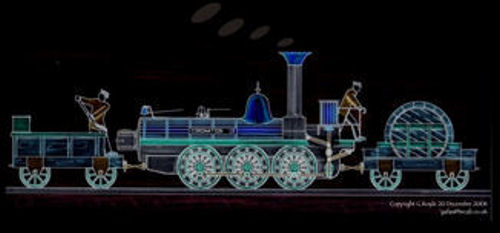
William's engine in JULY 1837
Majestic class, Coronation no. 13 was a double tender engine designed and built by Timothy Hackworth c.1831
with some parts made by Robert Stephenson & Co. and R & W Hawthorn Ltd, both of Newcastle-on-Tyne.
All that remains of this Class of engine are a couple of primitive sketchs made many years
after the engines were scrapped, hence this illustration is the webmaster's best guess.
The books listed at the foot of this page were very useful in the quest.
William was born and raised in East Hartburn, Stockton-on-Tees, the eldest son of George Brown a farmer of Ingleton, and Jane Lamb of Redmarshall, who married 17 May 1803 at Stockton-on-Tees, St.Thomas.
1803 Oct 30 William was baptised in the above church.
1831 Aug 15 He married Mary Orton of Hutton Rudby, at the above church. They had two girls and three boys, inc. my g.grandfather Robert. In 1821 Mary's father was sentenced to death at York Assizes. See her page in this site.
1836 William is believed to have been on the team which delivered an engine built by Timothy Hackworth to Russia. The former's granddaughter, Helena Brown in a matter of fact way told me [c.1950] that he was presented with a gold watch by the Tsar. I have heard that it was not unusual for Tsar Nicholas to dish out such gifts. So what happened to it ?
For example only.....
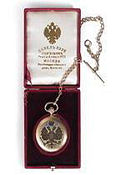
The following are monthly pay entries (out of sequence) in
the "Enginemen's Wages for July 1837".
| Drivers | Amount | Engines | Signatures |
| W.Brown | £40 18s 2d | Coronation-13 ( Majestic class pictured above ) | William Brown [33yr] |
| R.Morgan | £4 13s 11d | Locomotion No.1 ( the 1st engine on the line in 1825 ) | John Morgan |
| R.Newcomb | £30 9s 6d | Northumbrian-15 ( Majestic class ) | Elizth Newcome (sic) |
| J.Pickering | £36 4s 6d | Royal George ( The famous engine, built in 1827 ) | John Mountrey |
| J.Greathead | £35 13 5d | Shildon-18 ( Majestic class ) | John Greathead [22yr] |
- John Greathead married Ann Orton, sister-in-law of William Brown.
- It seems that the drivers were often absent from the pay parades due to pressure of work. Above, it appears that a couple of the drivers' wage packets were collected by relatives. [Reference on the Mary Orton ( fmfm ) page shows that W.B. signed his marriage contract with a 'X', so it is worth recording here that five years later he was signing these paylists properly with his full name, a testament to the fact that his employer Timothy Hackworth invested in the education of his workforce.]
- The amounts paid appear to be very generous by today's standards, however the drivers had to pay for their engine's coal and water, and their stoker's wages.
- Coronation No.13, was the last of the Majestic class to be retired from S&DR. In 1841 she was bought at auction in Shildon for £100 by her creator Timothy Hackworth.
Another paylist
example, for May 1837, can be seen here >
>
CLEVELAND
FHS
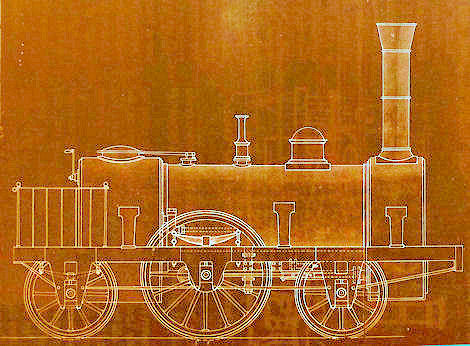
A side elevation of Raby Castle from Kitching's original drawing
Although new in 1839 the webmaster believes that Raby Castle was
in outline at least very similar to those engines delivered to the Tsar in
September of 1836, and said to have cost at least £2000 each.
The copper medal shown below was struck in Russia to commemorate the opening
of the Tsarskoye Selo Railway on 30 Oct 1836
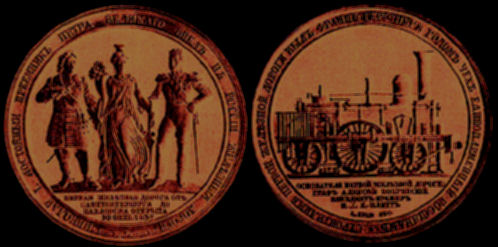
Note the 'family' resemblance of the engine depicted here with Kitching's drawing of Raby Castle.

The above image shows the remains of Bradyll ( ? ), an engine of the same era as 'Coronation'
though the identity is in some doubt. See http://en.wikipedia.org/wiki/Bradyll_(locomotive)
She can be seen at the Locomotion Museum at Shildon, County Durham. From the image it seems
that the missing cylinders were attached to the sides of the smoke-box,
(here painted black) and inclined toward the wheels at the far 'stoking' end of the boiler,
i.e not as Coronation's which were vertical and linked to the wheels
& connecting-rod via a crankshaft.
But - - - - :
I have sneaking suspicion that in an earlier life this relic was Coronation-13, the tired old engine
bought at auction in 1841 by her creator Timothy Hackworth.
It is common practice in engineering to use existing hardware as the basis of a new development.
The positions of the blast-pipe; chimney; and fire-box are a match, and my guess is that the boiler,
could be 4ft. diameter x 13ft. long, with 105 smoke tubes.
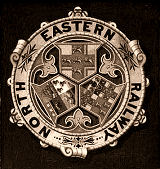
1873
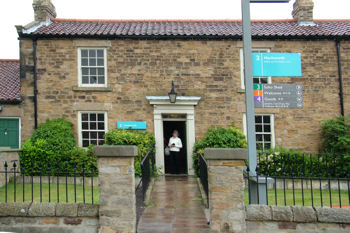
Hackworth House in August 2007
(My wife Dorothy at the front door)
Previously known as Soho House, it was home (1831 - 1850) of Timothy Hackworth.
I wonder if the engine-men of old queued on that path for wages ?
The locomotive finishing shop (demolished in 1946) would have towered over
the bungalows on the left.
1875 was the year
of the S&DR
Jubilee. J.S.Jeans, author of the official record
included a brief tribute to William Bouch :-
"The Shildon (Miner class) no.1033 was constructed thirty years ago - - - by Mr William Bouch. It has been running
continually since that time on the Stockton and Darlington line, and is yet, to all appearance, fit for a good deal of service."
(In 1969, Apollo 11 covered about the same distance on its way to the Moon. Ed.)

No.1033 Shildon (Miner class) 1845 - 1877
1876 January 19 William Bouch died age 63 at Melcombe Regis, Dorset.
The executor of his Will was his brother Thomas whose image
here I believe shows us a familial likeness.
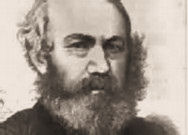
Thomas Bouch, civil engineer
1822 - 1880
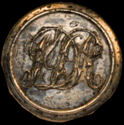
S.& D.R. coat button
Below, a different aspect of the setting used in 1873 for William's 70th birthday party. (go there)

Closing remarks on this romancing
For more than ten years my research-and-declare method has served me well.
I liken it to the relatively new science of geology as invented by
Dr James Hutton 1726 - 1797, hence Huttonian.
There's also intuition, exactly defined in Chambers Dictionary as :-
" The power of the mind by which it immediately perceives the
truth of things without reasoning or analysis. "
Through this experience I feel that acute intuition is in my genes
although not included in the results of my Ancestry-DNA test :)
- - - - - - - - - - - - - -
"Everthing inspires me, sometimes I think I see things others don't."
Norman Foster /architect, born Reddish, Stockport in 1935.
- - - - - - - - - - - - - -
There are more things in heaven and earth, Horatio, than are dreamt of in your philosophy."
William Shakespeare / Hamlet (1.5.167-8)

© 2008 - 2020 GEOFF ROYLE G4FAS
- The rails on which these engines operated pass through Goosepool. Coincidentally, during 1959-60 the webmaster served there in the Royal Air Force when it was known as R.A.F. Middleton-St-George. In those Cold War days 'Javelin' night fighters of 33 Squadron on final approach would cross the old S&DR line, and the beams of their landing lights would at times stream through the carriage windows of a passenger train. (As seen from the MSG Control Tower)
1839 July
Driver of No.15 Northumbrian (Majestic class, as was No.13
Coronation)
1839 December?
Timothy Hackworth resigned from S&DR to manage the Soho Works
at Shildon. (George Smith, NER Journal 2018, Vol. 57 p.91)
1841
Engine No.13
Coronation the
last of the Majestic engines in service was sold at
an
auction in Shildon for £100, apparently to Timothy Hackworth.
(pp 61-62, The Locomotives of the S&DR, by T.R.Pearce)
Did Mr Hackworth and his brother Thomas
use Coronation as the basis of the Bradyll
development ?
[LINK]
1841 The
family were living at East Thickley ( aka New Shildon ).
Their entry in the facsimile of
the 1841 census has faded, almost illegible, as the
enumerators
were
permitted to write in pencil. William
was recorded as an 'Engine-man'. Only the youngest
child
Robert age 6 (my g.grandfather) was at home and a search
revealed William's other children
living with their
maternal grandmother Elizabeth Orton, at The Elms, Hutton Rudby,
Yorkshire. [now no.5 North Side, n.e.corner of the village green, and
almost back to back with the Bay Horse public house]. The
Elms was the home of James Flounders, a retired farmer
and Elizabeth
Orton
wife of a convict deported to Australia. She was
related to
James by
marriage. James was a first
cousin of
industrialist Benjamin
Flounders one of the promoters
of the
Stockton and Darlington Railway Company. As William Brown
was
son-in-law of James Flounders' housekeeper, I wonder
whether this led to his secure employment
with S&DR ?
1842 Jan
10 The date of the
official
opening of the Shildon Tunnel between East Thickley and South Church.
The tunnel improved access northwards to the coalmines of the Wear
Valley; and especially all other traffic between Darlington
and
Bishop
Auckland.
The precise date might be disputed. I received it on face value whilst researching the life of stone mason 'Benjamin Benn' (link includes a photo). He (17) and/or his father it is said, actually worked on the Shildon Tunnel.
The precise date might be disputed. I received it on face value whilst researching the life of stone mason 'Benjamin Benn' (link includes a photo). He (17) and/or his father it is said, actually worked on the Shildon Tunnel.
1842
Driver of No.12 Trader (Tory
class)
which was a new engine in that
year.
1846 Driver of No.30 Wear (Miner class)
1846 Sept Driver of No.13 Ocean (Tory class) / was No.29
1846 Driver of No.30 Wear (Miner class)
1846 Sept Driver of No.13 Ocean (Tory class) / was No.29
1846
Oct
and 1847
Feb
Driver of No.49 Raby Castle. She
was a 2-2-2 coaching
engine in a class of her own. Herapath's Railway
Journal
in 1841 stated that "The Raby Castle is a beautiful engine for her size
and weight and second to none that I have yet seen. She is a
steady, active, neat, tight little engine capable of generating more
steam than she has the weight to apply to it".

A side elevation of Raby Castle from Kitching's original drawing
Although new in 1839 the webmaster believes that Raby Castle was
in outline at least very similar to those engines delivered to the Tsar in
September of 1836, and said to have cost at least £2000 each.
The copper medal shown below was struck in Russia to commemorate the opening
of the Tsarskoye Selo Railway on 30 Oct 1836

Note the 'family' resemblance of the engine depicted here with Kitching's drawing of Raby Castle.

The above image shows the remains of Bradyll ( ? ), an engine of the same era as 'Coronation'
though the identity is in some doubt. See http://en.wikipedia.org/wiki/Bradyll_(locomotive)
She can be seen at the Locomotion Museum at Shildon, County Durham. From the image it seems
that the missing cylinders were attached to the sides of the smoke-box,
(here painted black) and inclined toward the wheels at the far 'stoking' end of the boiler,
i.e not as Coronation's which were vertical and linked to the wheels
& connecting-rod via a crankshaft.
But - - - - :
I have sneaking suspicion that in an earlier life this relic was Coronation-13, the tired old engine
bought at auction in 1841 by her creator Timothy Hackworth.
It is common practice in engineering to use existing hardware as the basis of a new development.
The positions of the blast-pipe; chimney; and fire-box are a match, and my guess is that the boiler,
could be 4ft. diameter x 13ft. long, with 105 smoke tubes.
Read on for
transcript of
the footnote
Locomotive built by Mr Timothy Hackworth in honour of the coronation of King William IV-1831.
"Coronation" engine from needlework picture in the John Phillimore collection of early railway relics.
Forerunner of the "Coronation" 1937 L-N-E-R streamline train King's Cross and Edinburgh.
LONDON & NORTH EASTERN RAILWAY
Web-master's note :- The artwork/needlework in the poster is by Scottish artist Doris Zinkeisen 1898 - 1991
Locomotive built by Mr Timothy Hackworth in honour of the coronation of King William IV-1831.
"Coronation" engine from needlework picture in the John Phillimore collection of early railway relics.
Forerunner of the "Coronation" 1937 L-N-E-R streamline train King's Cross and Edinburgh.
LONDON & NORTH EASTERN RAILWAY
Web-master's note :- The artwork/needlework in the poster is by Scottish artist Doris Zinkeisen 1898 - 1991
1851
Census: William is not
at home in
Temperance Street, Shildon, but
another
census page shows him in
railwaymen's lodgings at Wolverton-St-George, Bucks (200 miles away)
together
with
another engine-driver, his
brother-in-law John
Greathead . I wonder if they
travelled to
Wolverton by
any of the engines mentioned above, such as Raby Castle ?

" Driver of 1852 "
by Henry Thomas Alken

" Driver of 1852 "
by Henry Thomas Alken
1861
Census
: William shown
as Inspector
of Locomotive Engines.
The
family were living in Adelaide
St., Shildon.
1861 Reference
only : Westmoreland
poet John Close wrote about characters he met on the railway station at
nearby Kirby Stephen. Among those were, in his words "Also
Messrs
Clough and Henderson, Mineral and Plate Inspectors and Mr Richardson,
engine inspector. All are
superior,
intellectual men."
1863 the S&DR
lost its independence
and was then operated as the Darlington Section of the North
Eastern Railway until
1876.

1871
Census
: William Brown shown as an Engine-driver.
The
family were living in Company's Row (Adelaide St) his youngest son
William-jnr 21,
(fitter) was present. His eldest son
George 37 (foundryman)
and family were living next-door.
1873
To date I have
published
190 pages for
this
website including 44 for my relation Ann (also a descendant of William
Brown). In 2012 it was Ann who brought
the following large photograph of engineers and a
locomotive to my
attention.
I believe it was snapped and framed in 1873 then
cherished through
five
generations. Ann and I had different grandmothers, remote from each
other, and both descendants of William Brown, who
told us
more or less the same story that " - - an ancestor
delivered the first locomotive to Russia - - ".
The original photograph lacks provenance, as to
the best of my knowledge it has neither labels nor a signature, also
Ann and her close family have been unable to identify any of the people
in the frame. However,
recognising my
great-grandfather's image in
both of the following photographs has encouraged me
to rethink the situation.
In
my opinion the
scene
was photographed in 1873 at Soho, Shildon
during the formal handover of a new engine to it's Danish buyers.
The date might have been William Brown's 70th birthday :
Wednesday the 1st of October 1873.
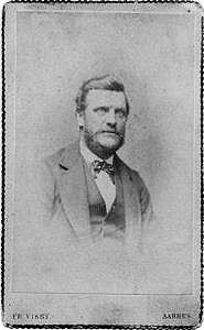 .....
.....
On the left, a Danish carte-de-visite by FR VISBY of my g.grandfather Robert Brown 37.
HFM Visby's pen and ink autograph is on the back of the card.
Robert can also be seen in the image of the large contact-print.
(I guess that the actual print, if it still exists is 8.5" wide.)
When the penny dropped, I realised that the four men standing on
the engine's running board are all Mrs Brown's boys ( see Mary Orton )
i.e. her son Robert 37; her husband William 70; her son George 39, and her son William 23;
and 'locomotive superintendent' William Bouch is in the foreground, fourth from the right.
All told : I think I see four Danes; four Browns; three N.E.R. principals; and two painters.
Considering the outlines of the engine and shed it seems that the heavy camera and
tripod were standing very close to Mr.Bouch's kitchen door, and that the freshly painted
engine was facing the main entrance of Timothy Hackworth's loco assembly/paint shop.
In previous issues of this page I assumed that Robert Brown's portrait photo,
annotated 'FR VISBY' & 'AARHUS' was taken in Denmark. However, I now think
that photographer Visby was actually present in Shildon as a co-opted member of
the Danish delegation and so it follows that he might have taken both photographs
perhaps using a dark-room technique to lift individual portraits from the large group.
For reference only : At the end of same month Visby's wife presented him with
a baby girl who later became famous as a writer, namely Thora Visby Petersen.
A search of the internet has found a likely candidate in Hans Frederik Meyer Visby
also known as 'Fred' Visby (1839 - 1926). The son of a clergyman of Aarhus he
was a well-heeled tourist who as a young man travelled widely in Central America.
After his return to Aarhus in 1869 he appears to have taken up photography as
an enterprise, and between 1874 & 1876 he had a studio/atelier at the corner of :
the Great Square and St.Clemens Torv in Aarhus
However as he lived until 1926 he is better remembered as a notable artist in oils
and watercolours. Images of his paintings can be found now in internet auctions etc.
Click on the portrait
V
Visby 1864
1864
"An interior with a young woman reading an Easter letter"
during the formal handover of a new engine to it's Danish buyers.
The date might have been William Brown's 70th birthday :
Wednesday the 1st of October 1873.
 .....
.....
On the left, a Danish carte-de-visite by FR VISBY of my g.grandfather Robert Brown 37.
HFM Visby's pen and ink autograph is on the back of the card.
Robert can also be seen in the image of the large contact-print.
(I guess that the actual print, if it still exists is 8.5" wide.)
When the penny dropped, I realised that the four men standing on
the engine's running board are all Mrs Brown's boys ( see Mary Orton )
i.e. her son Robert 37; her husband William 70; her son George 39, and her son William 23;
and 'locomotive superintendent' William Bouch is in the foreground, fourth from the right.
All told : I think I see four Danes; four Browns; three N.E.R. principals; and two painters.
Considering the outlines of the engine and shed it seems that the heavy camera and
tripod were standing very close to Mr.Bouch's kitchen door, and that the freshly painted
engine was facing the main entrance of Timothy Hackworth's loco assembly/paint shop.
- A sketch
to prove the
location can be seen here > > > (go
there)
In previous issues of this page I assumed that Robert Brown's portrait photo,
annotated 'FR VISBY' & 'AARHUS' was taken in Denmark. However, I now think
that photographer Visby was actually present in Shildon as a co-opted member of
the Danish delegation and so it follows that he might have taken both photographs
perhaps using a dark-room technique to lift individual portraits from the large group.
For reference only : At the end of same month Visby's wife presented him with
a baby girl who later became famous as a writer, namely Thora Visby Petersen.
A search of the internet has found a likely candidate in Hans Frederik Meyer Visby
also known as 'Fred' Visby (1839 - 1926). The son of a clergyman of Aarhus he
was a well-heeled tourist who as a young man travelled widely in Central America.
After his return to Aarhus in 1869 he appears to have taken up photography as
an enterprise, and between 1874 & 1876 he had a studio/atelier at the corner of :
the Great Square and St.Clemens Torv in Aarhus
However as he lived until 1926 he is better remembered as a notable artist in oils
and watercolours. Images of his paintings can be found now in internet auctions etc.
Click on the portrait
V
Visby
 1864
1864"An interior with a young woman reading an Easter letter"
Other factors
regarding the
loco-photo :
- The location was Soho, New Shildon. This village-within-a-village was from 1840 the home of a series of principal engineers (and their families) such as Hackworth; Bouch; MacNay; and maybe Bouch's successor Edward Fletcher. Their accommodation, two large terraced cottages are still there and remain now as a feature of the 'Locomotion' site of the National Railway Museum. The 1873 '70th birthday' photo was taken very close to the back of the cottages where, about 30 years earlier Timothy Hackworth had built his assembly shop. (For reference only: In the 1871 census a notable guest of the Bouchs was a lady listed as a ship-owner.)
- I believe Mr.Bouch 60 is in the group photograph, fourth from the right, and that the man third from the right is Mr.William MacNay 47, "Managing Engineer, Shildon Works". He was Bouch's next door neighbour.
- By 1873 locomotive assembly at Shildon had dwindled, so it was fortuitous for the local economy that engines made elsewhere such as Newcastle; Darlington; Bristol, and Glasgow could be brought in for painting and general finishing such as the application of company livery.
- Fortunately, I was helped by a pen friend (James Armstrong) to identify the locomotive:- No.61 was " - - the first of four 0-6-0s built by R & W Hawthorn Ltd of Newcastle for Denmark in 1873 - - ". The engine-driver seated on the sand-box and the gentlemen on the left in inky-black suits and shiny-shoes seem 'foreign' to me. Were they Viking officials of the Danish Government Railways ?
- Focussing on the engine, it bears an uncanny resemblance to the extant NER 1275 which can be looked up here. NER 1275 was designed by William Bouch and built in 1874, i.e. about a year after the Danish no.61 was exported. Generically I believe both engines are known as 'Stephenson Long Boilers'. An obvious difference between the two is that no.61 had outside cylinders.
- If I am right about Danish artist Fred Visby photographing the men-and-loco scene, we should applaud him for his thoughtful composition and choreography. He seems to have marshalled the group into five distinct parties. I think I see four Vikings; four Browns; three N.E.R. principals; two painters; and of course the inanimate star of the show, engine no.61 - - - (At this point, I must admit to unashamed kite-flying as it can stimulate positive feedback ! )
- William's son Robert was trained at Shildon under Mr Bouch; then around 1861 he took his family and skills to Doncaster; then to the Beyer-Peacock works at Gorton, Manchester; then in the early 1870s he returned to his homeland of Co.Durham with his wife Ann (Adamson) and seven daughters to reside in Westgate, Newcastle-upon-Tyne. His eighth daughter my grandmother was born there in 1876.
- On the day of the Shildon assembly the agenda would have included several photographs. Aside from the business photos ours is what I would call a foreigner, i.e. not on the books but I guess arranged ad-hoc at the discretion of Mr Bouch as a part of William's birthday treat. Mr Bouch would easily have covered the cost as after his death in 1876 his Will shows a probate valuation of about £160,000
- Mr Bouch; William Brown and his sons were Shildon villagers, and were among the last of the true S&DR men. As with any village there was the social network. For example in the 1840s Bouch's general manager was Daniel Adamson / W.Brown's son Robert married Adamson's niece / and there would have been times when W.Brown and W.Bouch chewed the fat over their individual experiences of working in Russia, i.e. W.Brown went to St.Petersburg in 1836 along with the 16 year old John Hackworth, and pre-1840 Mr.Bouch was, for a number of years, chief-engineer on a vessel in the Russian Navy. As for socialising in general there was of course 'the pub', such as the Grey Horse Inn which had served as the Adamson-nest for many years.
- We should not be surprised at the lack of evidence to substantiate my story. In the 1800s education was poor and illiteracy rife. For example in 1831 when William Brown and Mary Orton were married at St.Thomas' Church, Stockton neither of them managed their 'mark' in the register with a legible 'X'. However I know that Timothy Hackworth pushed his men into further-education, and that the facsimiles of the Engine-men's-Wages show us William's signatures written 'in a good fist'.
- Summarising the occasion from William's point of view. He would be pleased that his three sons had been rounded up to share his prominence on the engine. And, meeting up with the Danish engineers would have reminded him of his own excursion to St.Petersburg with the 16 year old John Hackworth.

Hackworth House in August 2007
(My wife Dorothy at the front door)
Previously known as Soho House, it was home (1831 - 1850) of Timothy Hackworth.
I wonder if the engine-men of old queued on that path for wages ?
The locomotive finishing shop (demolished in 1946) would have towered over
the bungalows on the left.
"The Shildon (Miner class) no.1033 was constructed thirty years ago - - - by Mr William Bouch. It has been running
continually since that time on the Stockton and Darlington line, and is yet, to all appearance, fit for a good deal of service."
(In 1969, Apollo 11 covered about the same distance on its way to the Moon. Ed.)

No.1033 Shildon (Miner class) 1845 - 1877
1876 January 19 William Bouch died age 63 at Melcombe Regis, Dorset.
The executor of his Will was his brother Thomas whose image
here I believe shows us a familial likeness.

Thomas Bouch, civil engineer
1822 - 1880
1885 Oct 19 William
Brown died
at
Company Cottages, New Shildon.
Remarkably at age of 82 his death certificate still gives his
occupation as
'Engine
Driver'. Later
William's
widow lived with her
daughter Ann's family at
Highside
House farm
Heighington. (The place is still there, now a Grade
2
listed building.)
An image believed
to have come to
light from an early postcard
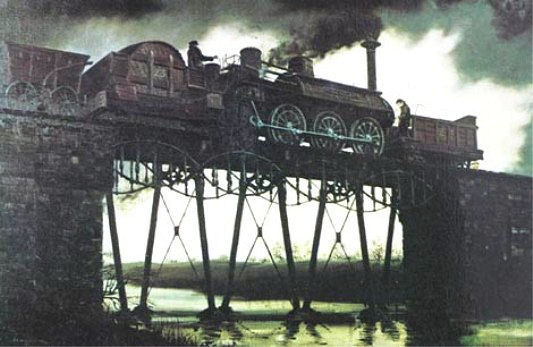
George Stephenson's viaduct which was built in 1824 (link) over the River Gaunless at
West Auckland, Co. Durham. Throughout its early development the railway
was supposed to carry only horse-drawn traffic, so it is surprising to see it
bearing an engine of the Director class, the first of which was delivered in 1832.
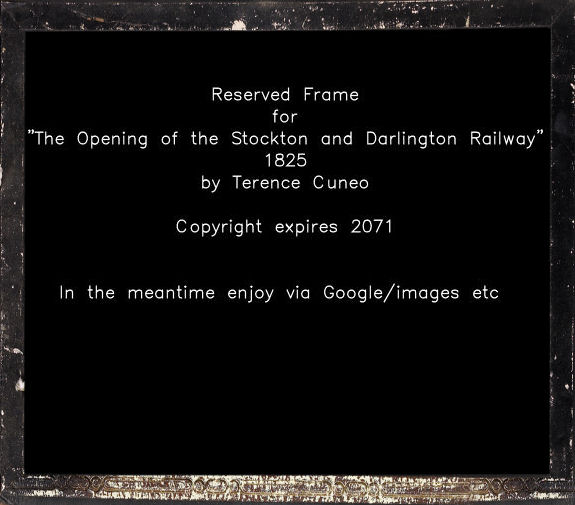
Painting by Terence Cuneo
27th of September 1825. The opening day of the Stockton and Darlington Railway had arrived.
Locomotion No.1 with fire in her belly is racing toward Stockton-on-Tees.

George Stephenson's viaduct which was built in 1824 (link) over the River Gaunless at
West Auckland, Co. Durham. Throughout its early development the railway
was supposed to carry only horse-drawn traffic, so it is surprising to see it
bearing an engine of the Director class, the first of which was delivered in 1832.

Painting by Terence Cuneo
27th of September 1825. The opening day of the Stockton and Darlington Railway had arrived.
Locomotion No.1 with fire in her belly is racing toward Stockton-on-Tees.
Recommended
reading from
which much of the above was gleaned :
The following YouTube link plays folk music appropriate to the life and times of our Enginedriver : Many thanks to 'Helen' of Helen Osborne Research Ltd. SW20 9LB for her professional work on my behalf at the National Archives.
- The Locomotives of the Stockton and Darlington Railway (ISBN 0 902835 14 9) by T.R.Pearce (1996)
- History of the Stockton and Darlington Railway (ISBN 0 85983 050 0) by J.S.Jeans (1875)
- Timothy Hackworth and the Locomotive by Robert Young (1925)
The following YouTube link plays folk music appropriate to the life and times of our Enginedriver : Many thanks to 'Helen' of Helen Osborne Research Ltd. SW20 9LB for her professional work on my behalf at the National Archives.

S.& D.R. coat button
Below, a different aspect of the setting used in 1873 for William's 70th birthday party. (go there)

Closing remarks on this romancing
For more than ten years my research-and-declare method has served me well.
I liken it to the relatively new science of geology as invented by
Dr James Hutton 1726 - 1797, hence Huttonian.
There's also intuition, exactly defined in Chambers Dictionary as :-
" The power of the mind by which it immediately perceives the
truth of things without reasoning or analysis. "
Through this experience I feel that acute intuition is in my genes
although not included in the results of my Ancestry-DNA test :)
- - - - - - - - - - - - - -
"Everthing inspires me, sometimes I think I see things others don't."
Norman Foster /architect, born Reddish, Stockport in 1935.
- - - - - - - - - - - - - -
There are more things in heaven and earth, Horatio, than are dreamt of in your philosophy."
William Shakespeare / Hamlet (1.5.167-8)

© 2008 - 2020 GEOFF ROYLE G4FAS
